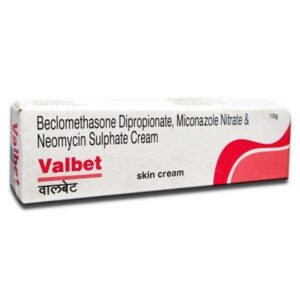BETAMETHASONE + NEOMYCIN + MICONAZOLE
Betamethasone: Betamethasone is a corticosteroid drug used to reduce inflammation and relieve symptoms associated with various medical conditions. It is available in various forms including oral tablets, topical creams and ointments, and injectable formulations.
The mechanism of action of betamethasone involves binding to specific receptors in the body’s cells. Once bound, it can inhibit the release of certain substances that cause inflammation. It also suppresses the immune system and prevents the production of substances involved in allergic reactions.
The specific dosage and duration of treatment with betamethasone vary depending on the medical condition being treated. It is important to follow the prescribed dosage and directions given by a healthcare professional.
Common side effects of betamethasone include:
1. Skin irritation, itching, or rash at the site of application (for topical formulations)
2. Thinning of the skin
3. Increased hair growth
4. Acne
5. Increased susceptibility to infections
6. Blurred vision
7. Mood changes
8. Difficulty sleeping
9. Increased blood sugar levels (especially in people with diabetes)
10. Fluid retention and swelling
It is important to note that betamethasone should not be used for extended periods without medical supervision, as long-term use can lead to more severe side effects such as adrenal suppression, osteoporosis, and increased risk of infections.
As with any medication, it is crucial to discuss potential risks and benefits with a healthcare professional before starting betamethasone therapy.
Neomycin: Neomycin is an antibiotic that is commonly used topically to prevent or treat bacterial infections. It belongs to the class of drugs known as aminoglycosides. Neomycin works by inhibiting protein synthesis in bacteria, thus preventing their growth and reproduction.
Neomycin is primarily used in the treatment of skin infections, such as impetigo, and for the prevention of infections in open wounds and burns. It may also be used in combination with other medications to treat certain eye infections.
When used topically, neomycin is usually applied in the form of a cream, ointment, or solution. The dosage will depend on the specific condition being treated and should be determined by a healthcare professional. It is important to follow the instructions provided by the healthcare provider or the product label.
Although neomycin is generally safe when applied topically, it can cause some side effects. Common side effects may include skin irritation, redness, itching, and burning at the site of application. In rare cases, it may cause an allergic reaction, characterized by rash, itching, swelling, dizziness, or difficulty breathing. If any of these symptoms occur, medical attention should be sought immediately.
Neomycin is not recommended for use in individuals who have a known allergy to aminoglycoside antibiotics. It should also be used with caution in individuals with kidney problems or hearing impairment.
As with any medication, it is important to discuss any existing medical conditions, allergies, or medications being taken with a healthcare professional before using neomycin to ensure it is safe and appropriate for use.
Miconazole: Miconazole is an antifungal medication used to treat various fungal infections. It is available in different dosage forms, including creams, gels, powders, and suppositories, allowing for its use in different areas of the body.
The mechanism of action of miconazole involves inhibiting the synthesis of ergosterol, a critical component of the fungal cell membrane. By disrupting the cell membrane, miconazole prevents the growth and proliferation of fungi.
Topical miconazole is commonly used to treat skin infections such as athlete’s foot, jock itch, and ringworm. It is also useful in treating vaginal yeast infections, oral thrush, and fungal nail infections.
The recommended dosage and duration of treatment can vary depending on the type and severity of the infection. It is crucial to follow the instructions provided by the healthcare professional or the product label for proper dosage and duration. Typically, the cream or gel is applied to the affected area once or twice daily, while suppositories may be inserted vaginally once a day before bed. The treatment duration can range from a few days to several weeks.
Like any medication, miconazole can cause side effects. Common side effects associated with its use include mild burning or irritation at the site of application. These effects are usually temporary and resolve on their own. However, if the irritation persists or worsens, it is advisable to seek medical attention.
Although rare, serious allergic reactions to miconazole can occur. Signs of an allergic reaction include rash, itching, swelling, severe dizziness, and difficulty breathing. If any of these symptoms are experienced, immediate medical help should be sought.
It is important to inform the healthcare professional about any known allergies or other medical conditions before using miconazole. Additionally, they should be notified of any other medications being taken, such as prescription drugs, over-the-counter medications, or herbal supplements, to avoid potential drug interactions.
Overall, miconazole is an effective antifungal medication used to treat various fungal infections. However, it is necessary to use it as directed and report any adverse reactions to a healthcare professional.

